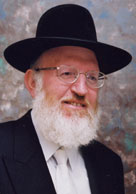Beit Midrash
- Sections
- Chemdat Yamim
- Bemare Habazak - Rabbis Questions
Answer: A proper job of double wrapping solves virtually any issue of heating things up in ovens. Sometimes, less is needed, and sometimes double wrapping is only a stringency. We will summarize the issue but will not be able to cover every circumstance.
The classic and surest way for a non-kosher food to transfer ta’am(a sufficient amount of particles to give off taste), and thereby make a kosher food forbidden is for them to make direct contact when they are hot. Yet, two other possible ways are discussed in the sources: 1. They are heated up in close proximity so that reicha (vapor) from one is liable to reach the other. When the vapor is strong/wet enough, it is calledzeiah, and the chance of significant transfer is greater. Which factors must be present for this to actually forbid the food, l’chatchila orb’dieved, is detailed, complicated, and includes machlokot, so it is beyond our scope (see Shulchan Aruch, Yoreh Deah 108:1). We will relate to scenarios in which the transfer is significant. 2. Heat and/or other factors cause particles to go from the food into utensils, from which they may go and "contaminate" other food that comes in contact with that utensil.
Now let’s analyze what can possibly happen in a treif oven. If one heats up kosher food at the same time with treif food, the vapor from thetreif food can enter the kosher food. Here, there is a clear requirement for double wrapping for the following reason. With a single wrap, the treiffood will make the wrapping treif. The hot kosher food on the inside of the single wrapping would then extract the ta’am from the wrapping and make the food forbidden. When working properly, the double wrapping ensures that there is nothing in between the two wrappings. Under those conditions, we say that ta’am is not transferred from one utensil directly into another one without the medium of a food or liquid (Rama, YD 92:8).
If the oven is "empty," then even if is there is edible non-kosher residue on the walls and ta’am within the walls, it is unlikely that it will produce enough vapor to cause a problem. The problem is that the vapor of the kosher food could provide the medium to transfer the treifparticles to the kosher food. However, to prevent this, it suffices to have a single cover to keep the vapor in (see Rama, YD 108:1).

Bemare Habazak - Rabbis Questions (631)
Rabbi Daniel Mann
245 - Rabbi Shimon’s Painful Return to the “Physical World”
246 - Double Wrapping Food in a Treif Oven
247 - Refusing Permission to Take Unwanted Things
Load More
If milchig and fleishig foods are being cooked or heated at the same time, wrapping only one of them with a single wrapping is not enough. The vapors of each can reach the wrapping, thus making it at that moment, both a milchig and a fleishig utensil, which is a problem (see Rama, YD 95:3). If it is only a milchig food in an empty fleishigoven, then the situation is similar (and perhaps a little more lenient – beyond our scope) to the case of an empty treif oven.
In the case of pareve food in an oven that is also baking fleishig, it is questionable whether one covering is enough to keep the foodpareve. It is no better than the level of pareve which people call "meat (or dairy) equipment," which has certain halachot of pareve and certain halachot of fleishig. Some say it is worse because the fleishig andpareve interact within the medium of the utensil that separates them at one and the same time (Chavot Daat 95:1). If the meat oven were empty, then as mentioned before, a sufficiently effective single wrapping would certainly succeed in preventing the oven’s meat element from affecting the pareve food. Again, one must ensure that no meat residue comes in direct contact with the utensil/wrapping.

Ask the Rabbi: Collecting Money for a Specific Medical Cause
Rabbi Daniel Mann | Tevet 5786

Ask the Rabbi: Giving a Tallit on a Sefer Torah to a Visitor
Rabbi Daniel Mann | Cheshvan 5786

Ask the Rabbi: Anonymous Return of Stolen Money
Rabbi Daniel Mann | Nisan 5785

Ask the Rabbi: Drawer with Aluminum Foil Roll
Rabbi Daniel Mann | Cheshvan 5786

Rabbi Daniel Mann

Reciting Kri’at Shema at the Very End of its Time
Sivan 21 5779

Cooking for Shabbat at the End of Yom Tov
Iyar 20 5783

Calling a Kohen Who is a Katan
Av 22 5777
























